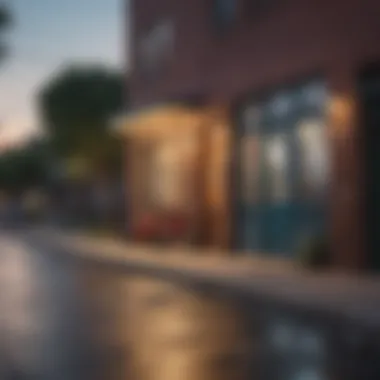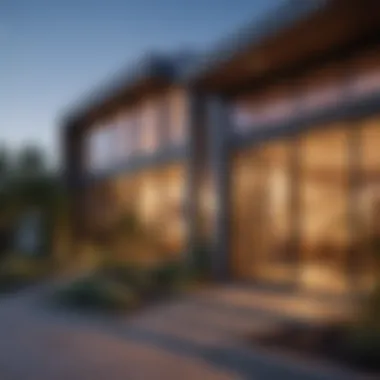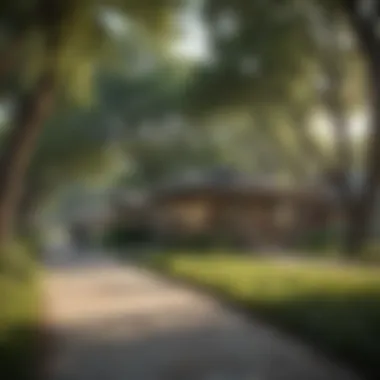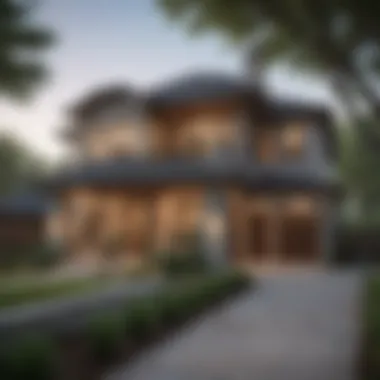Emerging Neighborhoods in Dallas: Key Insights


Intro
Dallas, known for its sprawling urban landscape and rich cultural tapestry, has long been a magnet for growth and innovation. As the city continues to expand, several neighborhoods are emerging as vibrant centers of community development and real estate investment. Understanding these neighborhoods provides not just valuable insights for potential homeowners but also for investors and city enthusiasts looking to grasp the evolving dynamics within Dallas.
This article aims to take readers on a journey through these burgeoning areas. We’ll explore their distinct characteristics, observe real estate trends, and examine the socio-economic factors that contribute to their rapid transformation. By delving into this landscape, you’ll uncover which neighborhoods are rising stars and how they integrate into Dallas's broader narrative of growth and urbanization.
Let’s first turn our attention to the homes that define these neighborhoods, offering a glimpse into the architectural diversity and design sensibilities shaping their evolution.
Prolusion to Dallas's Urban Evolution
Understanding the evolution of Dallas's urban landscape is crucial for comprehending the broader dynamics of the city and its emerging neighborhoods. As the economic heartbeat of Texas, Dallas has been undergoing significant transformations that directly affect its neighborhoods, influencing social and cultural environments, as well as real estate trends. Recognizing the shifts allows investors and residents alike to make well-informed decisions regarding their engagement with the city’s development.
In recent years, urban migration has led to a wave of new residents with diverse preferences demanding modern amenities and vibrant community spaces. As older neighborhoods adapt and new spaces arise, the fabric of the city continues to evolve, driven by economic opportunities and demographic changes.
Historical Context of Dallas Neighborhoods
To truly grasp the current transformation, one must venture back into the rich history of Dallas neighborhoods. Founded in 1841, Dallas has always served as a transportation hub, evolving from a trading post to a bustling metropolitan center. Each neighborhood carries its own story, reflecting the influences of various periods, from the post-World War II suburban expansion to the more recent revitalization efforts in historically significant districts.
For instance, Deep Ellum, once a center for African American culture in the early 20th century, faced decline in the latter part of the century but has experienced a renaissance. Today, it is known for vibrant live music venues and contemporary art spaces. Its transformation illustrates how neighborhood identity can shift while still resonating with historical roots.
By examining this historical framework, it becomes apparent how past events shape present-day dynamics. Several areas are noted for their architectural significance, such as the late Victorian buildings in the Bishop Arts District, which reflect an evolving residential environment. Each layer in the historical timeline contributes to the urgent need for development while preserving the essence of what makes each neighborhood unique.
Transformation of Urban Spaces
With the passage of time and shifts in societal norms, urban spaces in Dallas are experiencing remarkable changes. Traditional layouts are being reimagined to meet the demands of modern life. The introduction of mixed-use developments, like in Trinity Groves, illustrates a shift toward integrating residential and commercial spaces. This model not only enhances convenience but also fosters a sense of community, encouraging local businesses to thrive alongside vibrant housing options.
Moreover, enhanced public transportation options are reshaping the accessibility of neighborhoods. The Dallas Area Rapid Transit (DART) rail network is a critical player, reducing reliance on cars and encouraging a more pedestrian-friendly environment. This increased connectivity isn’t merely about transit; it is about building networks that enrich community interactions.
As more development proceeds, it is essential to approach transformation with an eye toward sustainability. Community gardens, pedestrian paths, and well-planned parks contribute richly to urban rejuvenation, promoting both ecological diversity and community engagement. Dallas’s future rests upon urban planners’ abilities to weave such elements into the ever-changing tapestry of its neighborhoods.
“Innovation is the lifeblood of a thriving neighborhood – the more we invest in urban spaces, the more we enhance the quality of life for residents.”
Keeping these essential factors in mind, the ongoing evolution of Dallas neighborhoods presents a plethora of opportunities for real estate enthusiasts, travel lovers, and design aficionados to engage and invest in a dynamic urban culture. It's a landscape full of stories, characters, and potentials—an ever-evolving narrative that promises exciting developments down the road.
Defining Factors for Upcoming Neighborhoods
The exploration of upcoming neighborhoods in Dallas can't go without examining the key factors that define their growth and appeal. These elements intertwine in various ways, significantly impacting the vibrancy and sustainability of these areas. Knowing these factors helps potential residents and investors make informed decisions, and it also lays the groundwork for understanding trends that shape the city's urban landscape.
Demographic Shifts and Preferences
Demographic shifts act as the bellwether for what's brewing in Dallas neighborhoods. Over recent years, there has been a noticeable influx of younger professionals drawn by the promise of opportunities and amenities. This trend often translates into evolving preferences for housing types, amenities, and community engagement. For instance, areas such as Bishop Arts District are gaining traction, partly due to their eclectic mix of cafés, art studios, and parks, appealing to a millennial crowd that loves both culture and convenience.
This changing demographic composition not only influences what people want from their living spaces but also affects the businesses that set up shop. The desire for walkability, community engagement, and local dining options is steering development toward mixed-use spaces where living, working, and socializing intersect. As preferences fluctuate, investors are increasingly paying heed, recognizing that catering to these shifts can yield lucrative returns.
Economic Growth and Job Opportunities
In parallel with demographic changes, economic growth acts as a propeller for emerging neighborhoods in Dallas. The recent surge in tech startups and creative industries—think of the buzz surrounding Deep Ellum and its tech incubators—has drastically reshaped the job landscape. More jobs mean more residents who are seeking homes nearby, thus accelerating demand for housing. This not only elevates construction projects but also fosters a more vibrant community ethos.
Residents now want spaces they can work from, meaning homes need to double as offices. Additionally, businesses are spurred to create services that cater to the workforce's evolving needs. Restaurants offering takeout, fitness facilities, and co-working spaces become staples in these neighborhoods. These shifts have long-term implications as they influence zoning laws and attract further investment.


Infrastructure and Transportation Developments
When one looks at any burgeoning community, infrastructure and transportation stand out as foundational elements. Improvement in public transportation, be it the DART rail expansions or enhanced bus routes, opens up previously marginalized areas, linking them to the city's core. This connectivity dramatically raises neighborhood profiles by making commuting convenient, changing residents' perceptions about distance and accessibility.
Moreover, planning new park spaces and retail developments ensures that neighborhoods aren’t just commuter zones but lifestyle hubs. Take Victory Park, for example. Recent investments in green spaces and community centers have transformed this locale into a bustling area filled with activity, drawing people who value recreation as much as productivity.
In summary, as Dallas continues to evolve, understanding these defining factors—demographics, economic growth, and infrastructure—becomes crucial for anyone interested in the future of its neighborhoods. These threads weave the complex tapestry that not only captures present trends but also forecasts exciting possibilities ahead.
"Neighborhoods are not just about geography; they're about the people who inhabit them and the opportunities available. Understanding these dynamics is essential for anyone looking to tap into Dallas's urban evolution."
Detailed Analysis of Key Neighborhoods
Understanding the key neighborhoods in Dallas is crucial for comprehending the city's urban evolution. Each emerging area tells a specific story marked by unique characteristics that illustrate the socio-economic landscape. This analysis shines a spotlight on how various factors coalesce to mold these neighborhoods, influencing their growth and allure. The importance of this topic lies in its potential to reveal not just where to invest or visit, but also what makes each community special.
Oak Cliff: A Cultural Renaissance
Art and Culinary Scene
Oak Cliff stands out for its raw and eclectic art and culinary offerings. This area buzzes with creativity and a sense of community spirit. Visitors and residents alike are attracted to its myriad of art galleries, vibrant murals, and locally-owned restaurants that serve everything from tacos to gourmet dishes. What sets Oak Cliff apart is its combination of authenticity and innovation. Artists and chefs here aren't just trying to make a living; they are also contributing to a cultural renaissance that reshapes local identity.
However, the rapid growth may come at a price. As new establishments draw in more patrons, longtime residents may find it difficult to keep up with changing tastes and rising costs. The cultural gem of Oak Cliff is, hence, a double-edged sword.
Real Estate Trends
Real estate trends in Oak Cliff indicate rising property values as new developments gain traction. Investors are eyeing this area for its potential returns. The key characteristic here is the eclectic mix of housing styles, from quaint bungalows to modern townhomes, catering to various demographics. This diversity makes Oak Cliff a solid choice for families and young professionals alike.
Yet, this popularity also raises concerns about gentrification, which could push out the very residents who helped shape the community. Balancing growth while maintaining affordability is a significant challenge.
Community Initiatives
Community initiatives in Oak Cliff spotlight a commitment to preserving local heritage while fostering inclusivity. Efforts to establish community gardens, festivals, and support for local businesses have created a sense of belonging. These mom-and-pop shops boost both the economy and local culture.
A distinctive feature of these initiatives is their grassroots nature, often led by residents who are passionate about their neighborhoods. Such efforts not only foster community engagement but also provide a buffer against potential negative impacts of development. However, sustaining these initiatives often relies on community involvement and funding, which can be inconsistent.
Bishop Arts District: A Blend of Old and New
Architectural Styles
The Bishop Arts District is a sensory delight—a blend of historic and contemporary architectural styles that narrate its evolution. The colorful buildings, many dating back to the early 1900s, coalesce with modern structures to create a unique visual identity. This juxtaposition is not merely aesthetic but signals a community that values its past while embracing the future.
The charm of the Bishop Arts District lies in its walkability, where connecting various architectural styles invites exploration. However, as new developments arise, there’s tension regarding preservation versus modernization. Keeping the character intact while adapting to contemporary demands is a significant hurdle.
Market Dynamics
The market dynamics of Bishop Arts indicate a steady increase in demand, especially among younger demographics. With its vibrant arts scene and community-focused events, this district is becoming a top choice for those seeking dynamic living conditions. Developers are rapidly responding to this interest, further fueling a bustling real estate market.
Notably, this surge can lead to heightened property values and potentially squeeze out existing residents. It becomes essential to consider the balance between attracting new residents while ensuring older community members aren’t disregarded.
Social Impact
The social impact of the Bishop Arts District is considerable. Not just a haven for local artisans, it also serves as a community hub that encourages social interactions. Events, exhibitions, and markets bring together diverse groups, fostering a sense of unity.


However, while the area thrives, challenges arise. The influx of businesses catering to new residents can alienate local artists and longstanding community members. Striking the right balance in fostering a genuine local culture while accommodating growth could be the distinguishing factor for this district.
Deep Ellum: Music and Innovation Hub
Historical Significance
Deep Ellum is more than just a location; it's a historical narrative woven into the fabric of Dallas. Once a hotspot for jazz and blues during the 1920s, this neighborhood honors its musical roots while evolving to embrace modernity. The cultural resonance of Deep Ellum is vital for understanding its contemporary significance.
Visitors often remark on the atmosphere infused with a rich musical legacy. However, while retaining its essence, there's ongoing debate about how to respect historical significance as new developments and businesses come in.
Current Development Projects
Current development projects in Deep Ellum aim to enhance its status as a cultural and creative district. With new venues, restaurants, and residential spaces emerging, the area's growth trajectory is robust. This development strategy is not just about physical space; it’s about creating an ecosystem conducive to innovation and creativity.
Yet, these projects also come with the risk of overshadowing the grassroots efforts that once gave Deep Ellum its vibrancy. Preserving the local art scene while accommodating new developments is an ongoing conversation among community members.
Quality of Life Considerations
Quality of life in Deep Ellum hinges on accessibility and community involvement. As it becomes a hub for creatives, the balance between tourist attraction and resident comfort is essential. Many appreciate the lively atmosphere filled with music and art.
On the flip side, some may find the area becoming too commercialized. Maintaining a pleasant living environment amid the bustle can be tricky. It's a balancing act between excitement and tranquility, making it a unique spot in Dallas.
Victory Park: A Modern Urban Experience
Commercial Spaces
Victory Park showcases a modern urban experience driven by its commercial spaces. This area is laden with high-end retail options, restaurants, and entertainment venues, attracting diverse groups. Consistency in quality and variety characterize its commercial offerings, making it attractive for businesses and shoppers alike.
The drawbacks, however, often relate to the high cost of entry for small businesses, making the area feel somewhat exclusive. Balancing luxury with accessibility remains a central theme in the community’s growth story.
Residential Development
Residential development in Victory Park is ambitious, with new luxury apartments and condominiums catering to affluent renters and buyers. This characteristic heightens its appeal for professionals seeking a cosmopolitan lifestyle.
However, introducing high-end housing triggers debates about affordability and access, which are vital for fostering a thriving community. Without careful planning, the risk of creating a polarized community is significant.
Urban Amenities
The urban amenities in Victory Park are top-notch, with parks, walking trails, and recreational areas enhancing the living experience. An essential characteristic of these amenities is their design and accessibility, inviting people to spend time outdoors and fostering social interactions.
Yet, amenities alone do not determine quality of life. They must blend seamlessly with transportation options and safety measures, ensuring that all residents can enjoy these communal spaces without fear.
Trinity Groves: Culinary and Lifestyle Destination
Restaurant Trends
Trinity Groves has gained recognition as a culinary hub, attracting food enthusiasts. The continuous emergence of innovative restaurants highlights the creativity bubbling beneath the surface. This area encourages partnerships with local chefs to promote variety, ranging from food trucks to fine dining.
Yet, the competition is fierce, and sustaining long-term success can be challenging. Some businesses flourish temporarily only to fade away, leaving a gap where local community support is crucial in keeping these spots alive.


Mixed-Use Development
The mixed-use development in Trinity Groves exemplifies modern urban planning, where work, dining, and living spaces coexist. This design draws both residents and visitors, creating a lively atmosphere that benefits everyone.
The unique feature of this development model is the ability to create vibrant communities. However, restrictions due to zoning laws may stifle character and growth, leading to frustrations among stakeholders.
Community Engagement
Lastly, community engagement in Trinity Groves shines through various grassroots initiatives. Local events designed to connect artists, businesses, and residents foster a sense of belonging. The positive aspect of such engagement is that it can lead to a vibrant, participatory culture.
On the other hand, garnering consistent participation can be a hurdle. Sustained community engagement requires ongoing effort and resources, leaving challenges for organizers who want to keep enthusiasm high.
Overall, the detailed analysis of these key neighborhoods reveals a narrative characterized by growth, community, and innovation, presenting both opportunities and challenges that define Dallas today.
Challenges Facing Emerging Neighborhoods
As neighborhoods in Dallas rise to prominence, they also face unique challenges that can shape their future. Growth often comes hand in hand with a set of difficulties that need addressing. Understanding these challenges is pivotal for anyone interested in the city’s evolution, particularly real estate enthusiasts, travel enthusiasts, and design aficionados. These challenges not only influence economic viability but also community cohesion, which is essential for sustainable growth.
Gentrification and Its Consequences
Gentrification is a double-edged sword. On one side, it brings investment, renovations, and an influx of new residents, but on the other, it can push long-standing community members out of neighborhoods they've called home for ages. In Dallas, the specter of gentrification looms over many emerging neighborhoods.
When property values soar, taxes often follow suit. This can create an untenable situation for residents, particularly low-income families. As the economic landscape shifts, many find it hard to cope with rising rent while trying to maintain their livelihood.
Furthermore, cultural displacement occurs as local businesses adapt to new clientele, often leading to the loss of long-established eateries and shops. Think of the small taco stand taken over by a trendy cafe—while tasty, it's also a symbol of what’s being lost. Gentrification brings an array of new amenities, yet these can feel alien to those who once enjoyed the neighborhood's authentic charm.
"There’s beauty in diversity, but we risk erasing the very fabric that makes our communities rich if we’re not careful with how we grow."
Maintaining Affordability
A related challenge is the ongoing effort to maintain affordability in rapidly changing areas. As neighborhoods attract more upwardly mobile residents, cost of living tends to rise. This can strain local services and infrastructure, placing additional burdens on public amenities.
Efforts to combat this issue include:
- Inclusionary Zoning Laws: Encouraging developers to include affordable housing in new projects, ensuring that a portion of homes remains accessible to various income levels.
- Community Land Trusts: These organizations buy and hold land, ensuring that it is developed for affordable use. They enable communities to retain control over local housing markets.
- Government Incentives: Incentivizing property owners to maintain lower rents for existing residents can help, but must be carefully managed to avoid discouraging investment.
The task of striking a balance between growth and affordability is delicate and requires strong community engagement and proactive policy-making. When done correctly, everyone benefits—new residents feel at home in their neighborhoods, while long-time locals continue to thrive in the places they love.
The End: The Future of Dallas Neighborhoods
The landscape of Dallas neighborhoods is ever-changing, and understanding their future is essential for anyone invested in real estate, community development, or urban design. The neighborhoods emerging today are not just segments of a city but reflections of broader social and economic trends. Recognizing the forces that shape these areas is crucial to grasping where Dallas might be headed in the future.
Long-Term Urban Planning Initiatives
Long-term urban planning initiatives play a pivotal role in shaping the neighborhoods of Dallas. As the city’s population continues to swell, the need for thoughtful planning has never been more pressing. This involves not just residential projects but also infrastructure improvements, like transportation enhancements and green spaces.
Local authorities are working tirelessly to forge a cohesive vision that embraces sustainability while catering to the community's needs. For instance, the Dallas City Council is championing plans that promote walkability, aiming to lessen the dependence on cars. Creating mixed-use developments not only fosters convenience but also enriches neighborhood culture and encourages local business growth.
"Urban planning isn't just about building structures; it's about creating vibrant communities that thrive together."
Potential for Sustainable Growth
Sustainability is more than a buzzword in Dallas; it's a guiding principle for future growth. Developers and city planners are increasingly considering how their projects impact the environment and the community at large. Innovations in green building practices and the use of renewable energy sources are becoming commonplace, which aligns with a growing demand from residents who prioritize eco-friendly living.
Moreover, sustainable growth encompasses social equity. It's no longer just about aesthetics or profit margins; rather, it's about building neighborhoods that welcome diversity. Efforts to engage residents in decision-making processes reflect a shift towards inclusivity, ensuring that the growth of Dallas benefits everyone.
In summary, the future of Dallas neighborhoods hinges on thoughtful planning and sustainable practices. As these communities evolve, they represent not only an opportunity for economic development but also a chance to foster vibrant, inclusive spaces where all residents can thrive.







